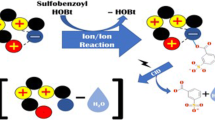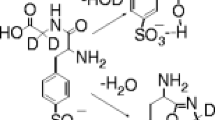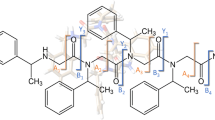Abstract
The protonated [M + H]+ ions of glycine, simple glycine containing peptides, and other simple di- and tripeptides react with acetone in the gas phase to yield [M + H + (CH3)2CO]+ adduct ions, some of which fragment via water loss to give [M + H + (CH3)2CO − H2O]+ Schiff’s base adducts. Formation of the [M + H + (CH3)2CO]+ adduct ions is dependent on the difference in proton affinities between the peptide M and acetone, while formation of the [M + H + (CH3)2CO − H2O]+Schiff’s base adducts is dependent on the ability of the peptide to act as an intramolecular proton “shuttle.” The structure and mechanisms for the formation of these Schiff’s base adducts have been examined via the use of collision-induced dissociation tandem mass spectrometry (CID MS/MS), isotopic labeling [using (CD3)2CO] and by comparison with the reactions of Schiff’s base adducts formed in solution. CID MS/MS of these adducts yield primarily N-terminally directed a- and b-type “sequence” ions. Potential structures of the b 1 ion, not usually observed in the product ion spectra of protonated peptide ions, were examined using ab initio calculations. A cyclic 5 membered pyrrolinone, formed by a neighboring group participation reaction from an enamine precursor, was predicted to be the primary product.
Similar content being viewed by others

References
Edman, P. A Method for the determination of the amino acid sequence in peptides. Arch. Biochem. Biophys. 1949, 22, 475–476.
Maxam, A. M.; Gilbert, W. A new method for sequencing DNA. Proc. Natl. Acad. Sci. 1977, 74, 560–564.
Inglis, A. S. Review. Chemical procedures for C-terminal sequencing of peptides and proteins. Anal. Biochem. 1991, 195, 183–196.
Stark, G. Cleavage at cysteine after cyanylation. Methods Enzymol. 1977, 47, 129–131.
Bornstein, P.; Balian, G. Cleavage at Asn-Gly bonds with hydroxylamine. Methods Enzymol. 1977, 47, 132–144.
Fontana, A.; Dalzoppo, D.; Grandi, C.; Zambonin, M. Cleavage at tryptophan with o-iodosobenzoic acid. Methods Enzymol. 1983, 91, 311–317.
Inglis, A. S. Cleavage at aspartic acid. Methods Enzymol. 1983, 91, 324–334.
Kamo, M.; Tsugita, A. Specific cleavage of amino side chains of serine and threonine in peptides and proteins with S-ethyltrifluorothioacetate vapor. Eur. J. Biochem. 1998, 255, 162–171.
Kawakami, T.; Kamo, M.; Tsugita, A. Bond-specific chemical cleavages of peptides and proteins with perfluoric acid vapors: Novel peptide bond cleavages of glycyl-threonine, the amino side of serine residues and the carboxyl side of aspartic acid residues. J. Biochem. 1997, 121, 68–76.
Vestling, M. M.; Kelly, M. A.; Fenselau, C. Optimization by mass spectrometry of a tryptophan-specific protein cleavage reaction. Rapid Commun. Mass Spectrom. 1994, 8, 786–790.
Glocker, M. O.; Borchers, C.; Przbylski, M. Molecular characterization of surface topology in protein tertiary structures by amino-acylation and mass spectrometric peptide mapping. Bioconj. Chem. 1994, 5, 583–590.
Suckau, D.; Mak, M.; Przybylski, M. Protein surface topology-probing by selective chemical modification and mass spectrometric peptide mapping. Proc. Natl. Acad. Sci. 1992, 89, 5630–5634.
Kim, I.-H.; Rodgers, G. P. In vivo footprinting using N-ethyl, N-nitrosourea: Improved resolution of the DNA— protein interactions in the human gamma-globin gene promoter region. Anal. Biochem. 1997, 254, 1–8.
Sasse-Dwight, S.; Gralla, J. D. Footprinting protein-DNA complexes in vivo. Methods Enzymol. 1991, 208, 146–168.
Karas, M.; Hillenkamp, F. Laser desorption ionization of proteins with molecular masses exceeding 10,000 daltons. Anal. Chem. 1988, 60, 2299–3201.
Fenn, J. B.; Mann, M.; Meng, C. K.; Wong, S. F.; Whitehouse, C. M. Electrospray ionization for mass spectrometry of large biomolecules. Science 1989, 246, 64–71.
Knapp, D. P. Chemical derivatization for mass spectrometry. Methods Enzymol. 1990, 193, 314–329.
Anderegg, R. J. Derivatization in mass spectrometry: Strategies for controlling fragmentation. Mass Spectrom. Rev. 1988, 7, 395–424.
Guan, Z.; Campbell, V. L.; Kaude, D. A. Charge state assignment from Schiff-Base adducts in low resolution electrospray mass spectra of protein mixtures and dissociation products. J. Mass Spectrom. 1995, 30, 119–123.
Le Blanc, J. C. Y.; Siu, K. W. M.; Guevremont, R. Electrospray mass spectrometric study of protein-ketone equilibria in solution. Anal. Chem. 1994, 66, 3289–3296.
Tsugita, A.; Takamoto, K.; Kamo, M.; Iwadate, H. C-terminal sequencing of protein—A novel partial acid hydrolysis and analysis by mass spectrometry. Eur. J. Biochem. 1992, 206, 691–696.
Chait, B. T.; Wang, R.; Beavis, R. C.; Kent, S. B. H. Protein ladder sequencing. Science 1993, 262, 89–92.
Bartlet-Jones, M.; Jeffery, W. A.; Hansen, H. F.; Pappin, D. J. Peptide ladder sequencing by mass spectrometry using a novel, volatile degradation reagent. Rapid Commun. Mass Spectrom. 1994, 8, 737–742.
Summerfield, S. G.; Bolgar, M. S.; Gaskell, S. J. Promotion and stabilization of b1 ions in peptide phenylthiocarbamoyl derivatives: Analogies with condensed-phase chemistry. J. Mass Spectrom. 1997, 32, 225–231.
Stults, J. T.; Lai, J.; McCune, S.; Wetzel, R. Simplification of high-energy collision spectra of peptides by amino-terminal derivatization. Anal. Chem. 1993, 65, 1703–1708.
Cardenas, M. S.; van der Heeft, E.; de Jong, A. P. J. M. On-line derivatization of peptides for improved analysis by microcolumn liquid chromatography coupled with electrospray ionization-tandem mass spectrometry. Rapid Commun. Mass Spectrom. 1997, 11, 1271–1278.
Miyagi, M.; Nakao, M.; Nakazawa, T.; Kato, I.; Tsunasawa, S. A novel derivatization method with 5-bromonicotinic acid N-hydroxysuccinimide for determination of the amino acid sequences of peptides. Rapid Commun. Mass Spectrom. 1998, 12, 603–608.
O’Hair, R. A. J. Designer reactions: Biomolecules in the gas phase. Chem. Australia 1998, September Issue, 50–53.
Reid, G. E.; O’Hair, R. A. J.; Styles, M. L.; McFadyen, W. D.; Simpson, R. J. Gas phase ion-molecule reactions in a modified ion trap: H/D exchange of non-covalent complexes and coordinatively unsaturated platinum complexes. Rapid Commun. Mass Spectrom. 1998, 12, 1701–1708.
Reid, G. E.; Simpson, R. J.; O’Hair, R. A. J. Probing the fragmentation reactions of protonated glycine oligomers via multistage mass spectrometry and gas phase H/D exchange in a modified ion trap. Int. J. Mass Spectrom. 1999, 190/191, 209–230.
Harrison, A. G. The gas-phase basicities and proton affinities of amino acids and peptides. Mass Spectrom. Rev. 1997, 16, 201–217.
Williams, E. R. Proton Transfer Reactivity of Large Multiply Charged Ions. J. Mass Spectrom. 1996, 31, 831–842.
Green, M. K.; Lebrilla, C. B. Ion-molecule reactions as probes of gas-phase structures of peptides and proteins. Mass Spectrom. Rev. 1997, 16, 53–71.
Gur, E. H.; de Koning, L. J.; Nibbering, N. M. M. The bimolecular gas-phase reaction of protonated alkyldipeptides with acetonylacetone. Int. J. Mass Spectrom. Ion Processes 1997, 167/168, 135–147.
Stephenson, J. L.; McLuckey, S. A. Gaseous protein cations are amphoteric. J. Am. Chem. Soc. 1997, 119, 1688–1696.
Stephenson, J. L.; McLuckey, S. A. Counting basic sites in oligopeptides via gas-phase chemistry. Anal. Chem. 1997, 69, 281–285.
Freitas, M. A.; O’Hair, R. A. J.; Dua, S.; Bowie, J. H. The methoxymethyl cation cleaves peptide bonds in the gas phase. Chem. Commun. 1997, 1409–1410.
O’Hair, R. A. J.; McLuckey, S. A. Trimethylsilyl derivatization of nucleic acid anions in the gas phase. Int. J. Mass Spectrom. Ion Processes 1997, 162, 183–202.
Pykalainen, M.; Vainiotalo, A.; Pakkanen, T. A.; Vainiotalo, P. Ion-molecule reactions of simple amines with carbonyl compounds in the gas phase. An experimental and theoretical study of enamine formation. J. Mass Spectrom. 1996, 31, 716–726.
Li, X.; Harrison, A. G. Structures of the adduct ions formed in the ammonia chemical ionization of ketones. J. Am. Chem. Soc. 1993, 115, 6327–6332.
Dayagi, S.; Degani, Y. Methods of formation of the carbon-nitrogen double bond. In The Chemistry of the Carbon-Nitrogen Double Bond; S. Patai, Ed.; Interscience: London, 1970, pp 61–147.
Hruby, V. J.; Yamashiro, D.; du Vigneaud, V. The structures of acetone-oxytocin with studies on the reactions of acetone with various peptides. J. Am. Chem. Soc. 1968, 90, 7106–7110.
Hruby, V. J.; du Vigneaud, V. The detection of a Schiff base intermediate in the formation of acetone-oxytocin. J. Am. Chem. Soc. 1969, 91, 3624–3626.
Cardinaux, F.; Brenner, M. N,N’-Alkylidenpeptide: Peptidsynthese-neben-produkte bei einwirkung von carbonylverbindungen. Helv. Chim. Acta 1973, 56, 339–347.
Nicholls, R.; de Jersey, J.; Worrall, S.; Wilce, P. Modification of proteins and other biological molecules by acetaldehyde: Adduct structure and significance. Int. J. Biochem. 1992, 24, 1899–1906.
Panetta, C. A.; Resh-Imam, M. The condensation of aldehydes and ketones with dipeptides. J. Org. Chem. 1972, 37, 302–304.
Means, G. E. Reductive alkylation of amino groups. Methods Enzymol. 1977, 47, 469–478.
Jentoft, N.; Dearborn, G. G. Protein labelling by reductive alkylation. Methods Enzymol. 1983, 91, 570–579.
Reid, G. E.; Simpson, R. J.; O’Hair, R. A. J. A mass spectrometric and ab initio study of the pathways for dehydration of simple glycine and cysteine-containing peptide [M + H] + ions. J. Am. Soc. Mass Spectrom. 1998, 9, 945–956.
O’Hair, R. A. J.; Styles, M. L.; Reid, G. E. Role of the sulfhydryl group on the gas phase fragmentation reactions of protonated cysteine and cysteine containing peptides. J. Am. Soc. Mass Spectrom. 1998, 9, 1275–1284.
Frisch, M. J.; Gill, P. M. W.; Wong, M. W.; Head-Gordon, M.; Trucks, G. W.; Foresman, J. B.; Schlegal, H. B.; Raghavachari, K.; Robb, M.; Johnson, B. G.; Gonzalez, C.; Defrees, D. J.; Fox, D. J.; Replogle, E. S.; Gomperts, R.; Andres, J. L.; Martin, R. L.; Baker, J.; Stewart, J. J. P.; Pople, J. A. Gaussian 94, Gaussian Inc.: Pittsburgh, PA, 1994.
Hehre, W. J.; Pople, J. A.; Radom, L. Ab Initio Molecular Orbital Theory: Wiley: New York, 1986.
Scott, A. P.; Radom, L. Harmonic vibrational frequencies: An evaluation of Hartree-Fock, Moller-Plesset, quadratic configuration interaction, density functional theory, and semiemperical scale factors. J. Phys. Chem. 1996, 100, 16502–16513.
Dongre, A. R.; Jones, J. L.; Somogyi, A.; Wysocki, V. H. Influence of peptide composition, gas-phase basicity, and chemical modification of fragmentation efficiency: Evidence for the mobile proton model. J. Am. Chem. Soc. 1996, 118, 8365–8374.
Wyttenbach, T.; Bushnell, J. E.; Bowers, M. T. Salt bridge structures in the absence of solvent? The case for the oligoglycines. J. Am. Chem. Soc. 1998, 120, 5098–5103.
Hunter, E. P. L.; Lias, S. G. Evaluated gas phase basicities and proton affinities of molecules: An update. J. Phys. Chem. Ref. Data 1998, 27, 413–457.
Ellenberger, M. R.; Dixon, D. A.; Farneth, W. E. Proton affinities and the sites of protonation of enamines in the gas phase. J. Am. Chem. Soc. 1981, 103, 5377–5382.
van Dongen, W. D.; Heerma, W.; Haverkamp, J.; de Koster, C. G. The b1-fragment ion from protonated glycine is an electrostatically-bound ion/molecule complex of CH2=NH2+ and CO. Rapid Commun. Mass Spectrom. 1996, 10, 1237–1239.
Yalcin, T.; Khouw, C.; Csizmadia, I. G.; Peterson, M. R.; Harrison, A. G. Why are B ions stable species in peptide spectra? J. Am. Soc. Mass Spectrom. 1995, 6, 1165–1174.
Yalcin, T.; Csizmadia, I. G.; Peterson, M. R.; Harrison, A. G. The structure and fragmentation of Bn (n equal to or greater than 3) ions in peptide spectra. J. Am. Soc. Mass Spectrom. 1996, 7, 233–242.
Paizs, B.; Lendvay, G.; Vekey, K.; Suhai, S. Formation of b2+ ions from protonated peptides: An ab initio study. Rapid. Commun. Mass Spectrom. 1999, 13, 525–533.
Zhang, K.; Zimmerman, D. M.; Chung-Phillips, A.; Cassady, C. J. Experimental and ab initio studies of the gas-phase basicities of polyglycines. J. Am. Chem. Soc. 1993, 115, 10812–10822.
Cassady, C. J.; Carr, S. R.; Zhang, K.; Chung-Phillips, A. Experimental and ab initio studies on protonations of alanine and small peptides of alanine and glycine. J. Org. Chem. 1995, 60, 1704–1712.
Author information
Authors and Affiliations
Corresponding author
Additional information
Dedicated to the memory of Professor R. R. Squires, an outstanding proponent of gas phase ion chemistry.
Rights and permissions
About this article
Cite this article
O’Hair, R.A.J., Reid, G.E. Derivatization of protonated peptides via gas phase ion—molecule reactions with acetone. J Am Soc Mass Spectrom 11, 244–256 (2000). https://doi.org/10.1016/S1044-0305(99)00142-7
Received:
Revised:
Accepted:
Issue Date:
DOI: https://doi.org/10.1016/S1044-0305(99)00142-7



